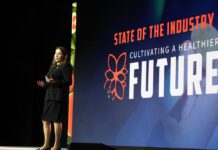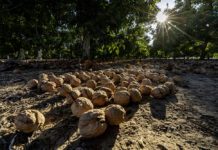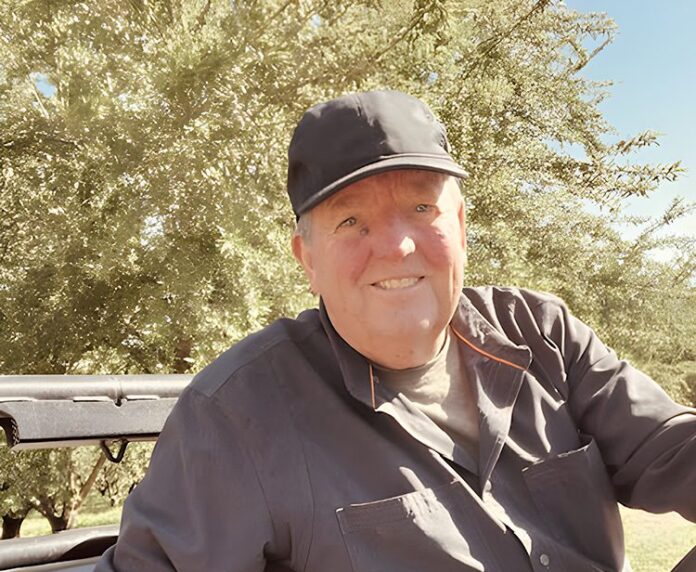
Scott Severson of Severson Family Farms is big on giving back to the next generation. He and his wife Kimber farm 65 acres of walnut and almond, some on land that has been in Kimber’s family since her grandparents immigrated to California from Japan in the 1920s.
Both Scott and Kimber come from families with a background in farming, and they know the importance of passing on their knowledge to the next generation. While the couple once farmed as much as 135 acres, it has never been their full-time job. Scott worked as a PCA while Kimber worked outside the ag industry. Now retired, Scott works with Almond Board of California’s Ag Leadership Program to invest in the next generation of farmers.
The Seversons entered the industry in the 80s and have seen a lot of changes over the decades. We asked Scott to share with West Coast Nut some of his thoughts on how the industry has changed and where he thinks it will go in the future.
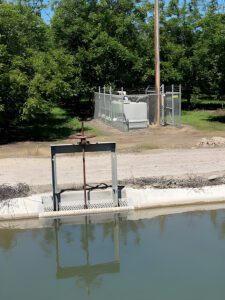
Q. Tell me a little bit about the family farm and how you got into farming.
My wife and I bought our first piece of property in either 1988 or ’89, and we bought it from my in-laws. Both of our families have come from farming families. My parents, that’s what they did, they farmed. Her dad farmed on the side, but they owned a small pharmacy in Turlock, and he was the pharmacist. They ran that little store, but the roots all come from farming for both of us.
I got my degree in plant science from Fresno State. I retired in 2022 as a licensed pest control advisor. I worked with growers. I had customers for over 36 years. Kimber had a different professional career.
Our farming kind of got started as a side business. We used our day jobs to pay for the farm and to purchase the ground and get it going. Our neighbor decided they wanted to sell properties, so we had the opportunity and were fortunate enough to be able to figure out how to purchase that. Then another neighboring property came up several years later, and we were able to purchase that piece. Then my parents decided they were done with the full-time farming, so we leased their property from them for several years.
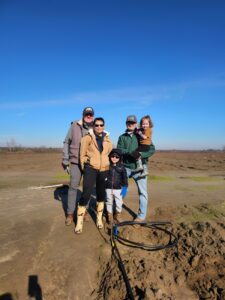
So, we’ve purchased. We’ve leased. We’ve actually sold some. My parents sold their property, so our farm has kind of grown, and now it’s shrunk back down to a much more manageable level in our retirement phase.
Today, we have about 65 acres split pretty evenly; 35 acres of walnut and 30 acres of almond.
I think what’s interesting is if we go to my wife’s side, her great-grandfather immigrated from Japan in the 1920s. And here, locally in the community we live in, the Cortez community, there were probably half a dozen farmers that were Japanese immigrants that started this community. And they started a co-op in 1924 called Cortez Growers Association. This year, the co-op is still operating, and they’re celebrating their 100-year anniversary.
It’s a pretty amazing story. The property has been in their family since the ’20s. They had to go through internment camp and all that mess in World War 2. They were lucky enough to have some landowners here, farmers locally, that were tenants of all the properties around here, and so when they got out of the internment camp, they still had their property here. They weren’t in great shape, but they at least had their property where they could come back and continue and develop their farming operations.
On my side of the family, we’re transplants from Orange County. My family and I moved up here when I was a year old and started farming up here in Central California. But my grandparents farmed on the Irvine ranch down in Irvine when it was still all ag land and not roads.
Q. How have farming practices evolved over your career?
It has certainly gotten more mechanized. I think of our harvest process; it’s equipment. Technology has grown so the amount of people it takes at harvest time to shake the nuts on the ground, sweep them in wind rows and pick them up and deliver them is really down to just a couple of people in that process where it used to be all hands on deck. When I was a kid we hand-raked the almonds out from the trees, and we had a sweeper that would sweep them into the final row. But you had to, at least, the first step was you had to hand-rake them out from the rows, and they used to hand knock the trees. You’d have crews that would climb into the trees with mallets and physically hit the limbs to knock them down. You go to the equipment show and look at what’s available now, and it’s just incredible.
Q. How have production practices changed?
Precision irrigation, drip and micro. When I first started in the business of farming, micros and drip were really kind of new and not necessarily mainstream at that point. There was still a lot of flood irrigation, impact sprinkler irrigation.
When it comes to the whole growth of the nut industry in California, part of that is because of changes in irrigation techniques. You can now farm in the foothills because you don’t need to have flat ground to flood. So, that’s where the big expansion started is after the drip and micro technology really began to get a foothold.
Another big change I’ve seen in my career is genetics. When I first started in the business, there were maybe two to three available rootstocks to choose from. Now there’s probably at least 10, if not even more, that have allowed growers to plant in areas that maybe weren’t suitable or the ideal to grow almond or walnut.
Then varieties. I mean, we’ve got self-fertilizing common varieties now that require very few bees, if any. I think it’s a big reason the industry has grown geographically because what works up maybe up in Sacramento Valley doesn’t necessarily mean it’s going to work down in Kern County. It has allowed farmers to be able to grow in a variety of soil types and climatic conditions.
Q. What is your proudest achievement when it comes to your career?
I was lucky enough to learn from a lot of people who were smarter and more experienced than me. So, as I began to get smarter and more experienced, I really tried to pass that down to the next generation the same way it was handed to me. I feel pretty good that I was able to help develop some younger people in the industry that are now very successful and doing really well. That’s probably more than anything, the most important to me.
Q. What are the three things that keep you up at night when it comes to growing tree nuts?
First of all, not a lot keeps me up at night, but water is a big deal right now, and I’m sure you’re well aware there are major changes going on in California through SGMA and the availability and the quantities of pumping, and that’s all evolving. I don’t think any of us really know what exactly it’s going to look like, but it is going to be different than it is now.
There’s no question it’s going to impact not only just the nut industry but the whole agricultural industry going forward. I mean, things are happening. You’re starting to read about things that are happening. That’s one area I stay pretty involved with. I sit on our local water district board, so it kind of keeps me engaged in the industry a little bit. But it’s also going to change. There will be some areas in California that will really be impacted hard as far as growing the nut crops.
And then climate change. You know, we can all argue about causes and solutions and things, but there’s no question our falls are longer. Our winters have been warmer. When I started in the business, it was not uncommon in the wintertime to go for two to three weeks without seeing the sun because of the fog. And I was always told that was what made the San Joaquin Valley and the Sacramento Valley very unique, that allowed us to get all our chill hours and dormancy hours for the permanent crops that needed that.
We just don’t get very much of that anymore. The warmer winters make it really difficult on the high chill-required permanent crops. Walnut would be one in the nut crop side, pistachio. Almonds don’t require quite as much. It hasn’t really impacted the almonds so far. It clearly has impacted some of the permanent crops.
Then there’s the extremes in rain. It just seems like we’ll be behind our normal rainfall amounts then in three weeks, we’re 50% over our average, so it seems like our rain events are just not as frequent. But when we get them, there’s a lot of rain, which makes it hard to get out in the field and do things. Where that’s going to go, who knows? But it definitely has made it more challenging.
The last one is the viability of small family farms going forward. It’s going to be challenging. My parents raised a family of five on 55 acres of almonds and peaches. We lived a nice, middle-class lifestyle. There’s no way. It would probably take a couple of hundred acres now, if not even more, to be able to just live off a farming income, so that makes it challenging. I think most of your operations our size are going to be side businesses.
Q. How is it different to be a small family farm versus a much larger farm?
It’s difficult because you need the capital to own equipment. Everything’s just so expensive right now. To justify buying a $100,000 tractor with a nice cab on it is difficult for a small family operation. So, what you’re seeing is maybe outsourcing certain practices now because it’s more cost-effective to pay someone to come in and do things like spraying an orchard than it is to own all your own equipment and do it yourself.
I think the other thing is just finding, if you’re going to outsource and have people help you, those people and making sure they’re willing to come into a small operation. There’s always a tendency to go to the larger customers. As a small farming operation, you have to really build relationships with your vendors and make sure that you pay your bills on time. You want to give them every reason to come and want to do business with you.
It’s more of a lifestyle, really. I mean, even in good years, in our operation, our size, it’s not enough to change your lifestyle. And it’s in your blood, so you just don’t want to give it up. It’s not for everybody. There are days you don’t go to the lake with everybody else. There are nights where you don’t go to bed at a normal time. Sometimes you have to miss birthday parties, those kinds of things.
Q. What are you most hopeful for in the future when it comes to the tree nut industry?
I think the important thing is for the industry to stay viable. Clearly, it’s important that consumption continues to increase globally through innovative products.
The current state the industry’s in right now, it is not viable. There are very few people making money at it right now, probably a lot more people that maybe break even, but I think the majority of people are actually losing money right now.
They just released the bearing acreage from the Almond Board, and it actually dropped for the first time since ’95, I think it was. For the industry to be viable, consumption is going to have to continue to increase both for almonds and walnuts, or it’s going to be tough going forward.
For probably anybody that’s 45 or younger, the current economic situation we’re in, none of them have ever faced this. When I first started in the business, in the mid- to late 80s, it was pretty similar. We had high inflation, people were losing their properties, and banks were repossessing things. There’s not as much of that happening now, but the economics were tough. I remember that, and I wasn’t really wise enough to know everything that was going on. But as I look back, I’m thinking, man, when I first got into the industry it was just like this.
Q. What do you think needs to happen for the industry to be viable?
The almond industry, through the Almond Board, they’ve done a really good job. The perfect storm happened. All this new acreage came into production, you had the pandemic, and everything that happened with that. Now you’ve got the economy and inflation and the world economy. It was the perfect storm that just really put the brakes on in the almond industry.
But they’ve been pretty advanced and are impacting the increase in consumption globally. I think that, within another couple of years, things are going to start turning in the industry.
The walnut industry was further behind. We just did not do a good job building that demand globally until we realized we were in a problem. The Walnut Association now is kind of retooled and has refocused what they’re doing, and it appears they have a good plan and are executing their plan. It’s starting to show some early impacts of that, but I think it’s going to take longer because we’re just further behind in that effort compared to the almond industry.
Q. What do you think needs to happen to set the industry on the best possible path?
I think it’s happening right now in this reset moment. Growers are going to get smarter. They’re going to become more efficient because if they’re going to survive right now, they have to. I think that’s going to be what it takes.
Going forward, you’re just going to have to continue to adjust your operation to be more efficient. People will have to rethink what they’re doing and how they’re doing it.
Q. Talk a little bit about sustainability.
Ten to 15 years ago, when that term first came into play, growers just dug their heels in, and it was like, “No way I’m going to.” But fast-forward to where we are now in the industry, and it’s pretty amazing how many growers have adapted to the concept.
I think growers have stopped just listening to themselves and their own small groups, and they’ve begun to realize that the consumer, especially the consumer we’re looking at now and going forward in the future, not only are they interested in nutritious food, but it’s very important how that food is grown. I applaud the Almond Board for trying to get in front of that and message it. They’ve done a great job of messaging over the last four or five years on how we grow our almonds.
The Almond Board has a self-reporting system called the California Almond Stewardship Platform (CASP). You kind of score yourself then you can choose to share that with your handler. Some handlers are actually paying an incentive now to complete the self-reporting CASP.
It’s things like we grow cover crops and the pollinator health concept. The industry has really changed, and so have we. It’s important, and every year it seems like more of the industry jumps on board. There are still some that are slow to adapt, but I’m totally convinced that if our consumers or our future consumers don’t like the way we grow our nut crops, they will find another alternative.
I know almonds, but I’m not who I’m selling my almonds to. We’re selling to a completely different clientele than ourselves. That’s been a challenge.
Assuming our grandkids live a normal longevity life, they’re going to be alive after the turn of the century. And you wonder what we’re going to hand to them. I mean, what’s this place going to look like? It makes me and my wife think of things differently now that our pace has slowed down, and I think these practices that we’re incorporating into our operations are good and hopefully, our handlers can share those stories and the Almond Board can share their stories and we’ll be compensated accordingly because it does increase your cost of operation.
In 2023, we had the opportunity through the Almond Board to host some influencers on our farm, and it just blew me away. It was really interesting to watch from the beginning to the end after they heard the story of the family farm. We were redeveloping a block right next to where they were at, so we were doing the whole orchard recycling. We just removed an orchard, chipped it, and were getting ready to incorporate it so they could see what we were doing there.
I asked people from the Almond Board after it was done, I said, “How do you know if they were impacted?” They were monitoring all their social media, and they could just tell it was successful by the number of hits on their Instagram sites and all the activity that was going on. That’s when I kind of realized that advertising has changed in a big way. It was interesting how information moves and where people find it. I now have a completely different perspective on social media and the impacts these influencers have on marketing a crop, or whatever it is they’re marketing. It’s pretty amazing.
Q. What do you think are the biggest assets of the nut industry in California?
We have a great product that’s healthy, nutritious, high quality, and is versatile, both for almonds and walnuts. And I think that’s our biggest asset.
We may not have as much good water, but we have really good water for the most part in the state, so we can grow this abundance of healthy, nutritious nuts.
And through the Almond Board, we’ve got smart people that can help us build that demand out, and that’s another huge asset. There’s a lot of smart, innovative people in this industry, so they’re a huge asset.
Q. How do you give back to the community?
Our community here, this Cortez community, is small, so it’s all hands on deck when something needs to happen. There’s nothing formal; it’s just everybody knows, everybody pitches in.
I do volunteer with the Almond Board in their Ag Leadership Program as a mentor. When I retired, I was approached by the Almond Board asking if I’d be interested. It’s fun because you get to be around all these young movers and shakers in the industry, and that gives me hope when I’m around groups like that. It keeps me engaged a little bit in the industry, too, and it’s just a way of sharing some of my experiences, good and bad, with other people.
Q. What advice would you have for a young person who wants to get into the industry today?
That would be a hard one. I was reading one of your previous articles about family farms, and he said it just isn’t going to basically happen. And I kind of have to lean with him on that.
But stranger things have happened. Maybe a neighbor wants to get out of farming, but they don’t want to sell the ground. So maybe you can arrange to lease the property. I think there are still ways you might be able to get into it.
But I think the biggest takeaway I would have for someone young is that you have to find trusted people to advise you because you can’t afford to make a mistake. If you make a mistake, it’ll probably bankrupt you.
You have to figure out who your trusted advisors are, whether that’s in the banking side of it, the crop production side of it or the processing side of it. You have to do your due diligence and forge those relationships and lean on those people to help you through that process because it can be daunting, especially if you don’t have a background in it.
Q. Who was your biggest mentor?
I would say, obviously, my parents. I mean they instilled that work ethic and the passion to farm in me. And beyond that, I’ve had several. I had several customers who were my mentors. They are now retired, and we still get together and visit, but there have been so many in my professional career. You really just can’t name one.
You’re impacted by so many different people, and I was lucky to be around really good people that I worked with, worked for, and customers that I worked with for decades. I probably learned more from my customers than I did anywhere else, good and bad.
That’s why Kimber and I are lucky because we had this huge resource of information that we could make our decisions on versus trying to find things on the internet or just real hands-on experiences from other farming operations.
Q. What advances do you see having a big impact in the future?
I think one of the areas that will be interesting to see how it evolves is the efforts to reduce dust at harvest time and how people are experimenting with off-the-ground harvesting. How is that all going to look 20 years from now? That will be an interesting one to watch.
Technology’s going to change, and we’re going to get our precision irrigation even better, our fertilization’s going to get better, and equipment’s going to get more efficient. It always has, and I think it always will. Going forward, farmers are innovators, and they’ll figure it out. They’ll figure out a way to do it if you just let them do it.







